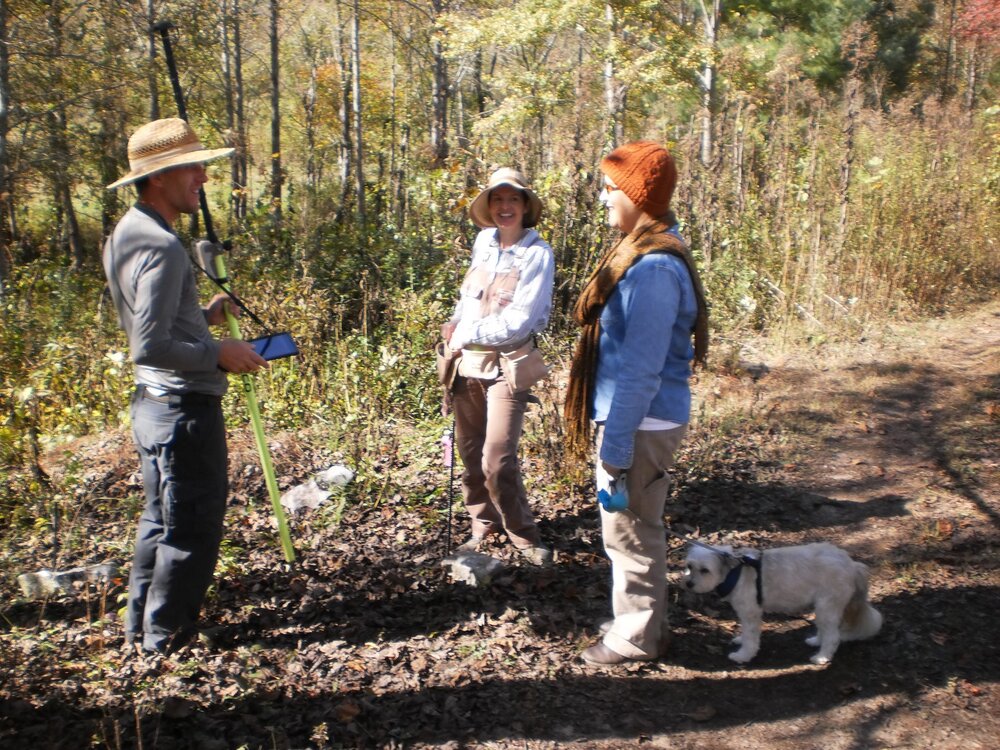A Buddhist lay minister asks ‘What is a good death?’
Manage episode 407776691 series 3563806
Caroline Yongue runs a small, green burial center in Western North Carolina. It’s part of a project to change how Americans approach death and grief -- creating new ways to live with loss, from the ground up.

Caroline Yongue (in orange cap) talks with colleagues as they use GIS to map the location of graves throughout the Sanctuary. PHOTO CREDIT: Jess Engebretson
Listen and subscribe to The Spiritual Edge wherever you listen to podcasts - Apple Podcasts, Spotify, Google Podcasts.
By Jess Engebretson
On a sunny October morning in North Carolina, the Carolina Memorial Sanctuary’s small staff gathers in a clearing. Sumac and blackberry brambles are waist high, and blue jays shriek at the small group from a stand of pines. There’s a burial the next morning, and the weather forecast is iffy. The Sanctuary’s founder, Caroline Yongue, is worried: do they have a tent large enough to cover the grave?
Rain isn’t just an inconvenience. Wet soil slows the body’s decomposition. At the Sanctuary, these details matter. The goal is to return the body’s nutrients to the land, nourishing the surrounding plants and animals. Graves are dug by hand, just three feet deep. Shrouds and coffins must be biodegradable, and embalming — which requires toxic chemicals — is not allowed. Staff are working to root out invasive species, support native plants, and rebuild fragile ecosystems. The land is legally protected from future development.
Caroline had dreamed of building such a place for years. She came to death work in the 1990s, when a member of her Buddhist community died. The group didn’t have much experience with Buddhist death traditions, so Caroline’s teacher asked her to learn more about the subject. Soon, she was walking her Buddhist community through deaths. Then she was helping friends and friends of friends from other faith backgrounds. She learned that almost everyone was unprepared for death. “We’re in a culture that doesn’t look at death and doesn’t hold it,” she says. Her goal? To change that culture, one person at a time.
The first step was teaching. Caroline offered classes with names like “Preparing for Your Own Good Life and Death” and “Home Funeral Training.” She asked students to tackle hard questions: What is a good life? What is a good death? How would I like to die? She walked them through the practicalities, too — how to keep a body cool, how to wrap a shroud.
Then, in 2015, Caroline took a gamble. She sold her house and used the money to buy a beat-up dairy farm: eleven acres of wetland and forest tucked up against a swath of soybean fields. Today, the Carolina Memorial Sanctuary is a patchwork of meadow and trees cut through by walking paths. Low graves are visible through the grasses, the more recent ones adorned with pine needles, sumac berries, and flowers. Some of her former students and friends are buried here. One day, Caroline will be, too. In the meantime, she keeps busy — sitting with grieving parents, ordering more bamboo urns, giving tours to adults cautiously contemplating their own mortality. Preparing for death, it turns out, is the work of a lifetime.
* * *
The Sacred Steps series is produced by KALW’s The Spiritual Edge. This story was made in collaboration with USC’s Center for Religion and Civic Culture and Religion News Service. Funding comes from the John Templeton Foundation and the Templeton Religion Trust. This story first aired on KALW Public Radio on May 26, 2020.
17 tập




